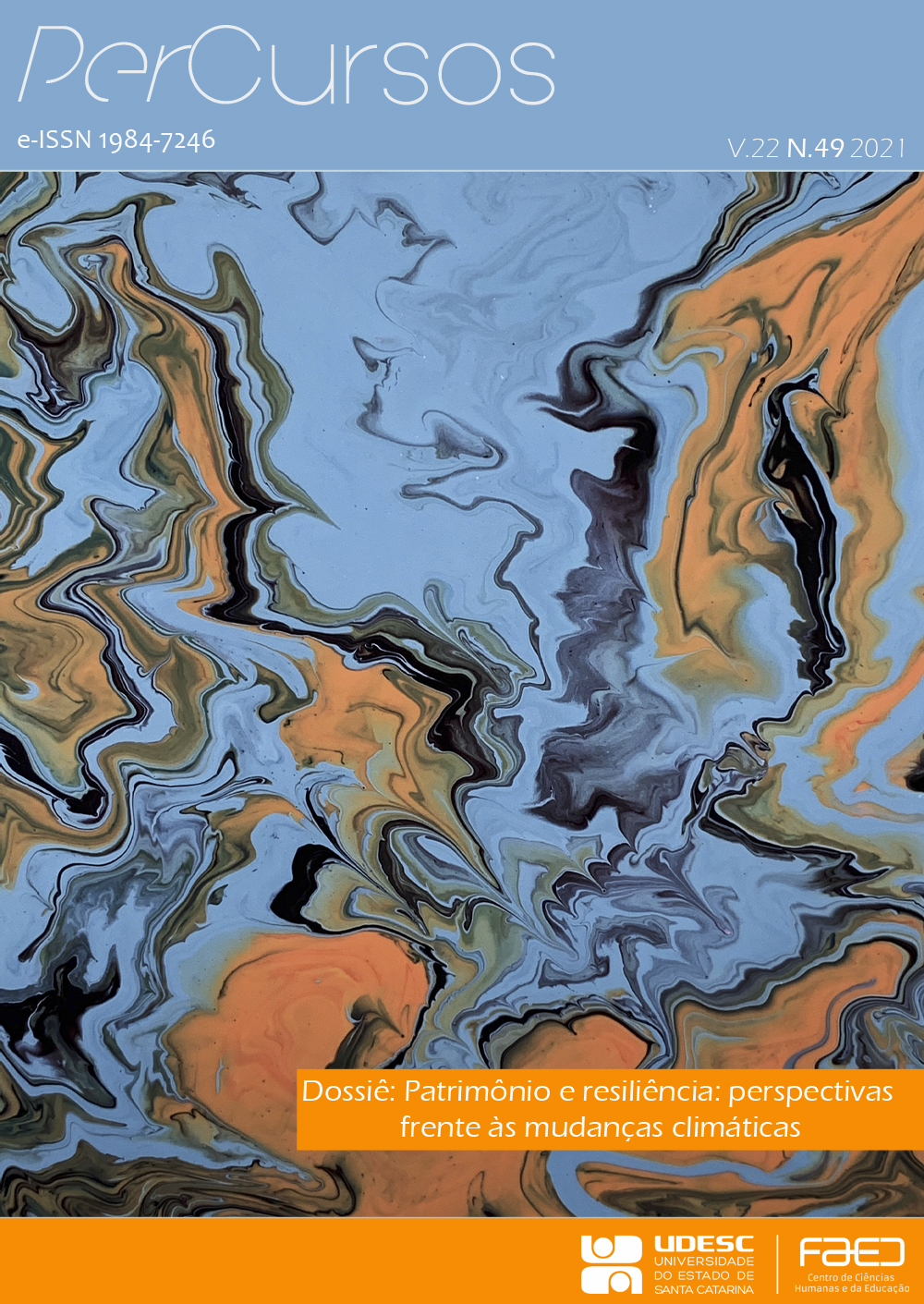Regenerative urbanism and heritage: pathways towards urban resilience in response to place
DOI:
https://doi.org/10.5965/1984724622492021124Keywords:
urban renewal, sustainable urbanism, special preservation interest areas, cultural landscape, systematic reviewAbstract
Understood as a process of urban intervention aimed at recomposing the biosphere, regenerative urbanism is one of the most prominent themes in achieving resilience in urban environments today. The research that gave rise to this article intended to explore regenerative urbanism concept, in a holistic understanding, through the elaboration of a systematic review. As a preliminary result, we observed that this new intervention paradigm acts both to achieve urban sustainability as well as a sensitive reading and consideration of the preexisting city. Considering this, the article seeks fundamentals for constructing a reflective process in decision-making for urban renewal actions with aims of resilience to climate change impacts. By reflective process, we consider knowing the exact measure of what is possible to develop, in terms of ecological performance, in preexisting areas, in which identity must be respected. To this end, we carried out a broad theoretical review in order to both problematize regenerative urbanism in relation to preexistence and landscape, as well as to build a propositional path for the dilemmas established in this relationship. We systematized a synthesis of good practices and procedures based on the foundations and conceptual review taken from literature that approaches regenerative urbanism in relation to preexistence and genuine aspects of a place that must be respected.
Downloads
References
BROTO et al., Vanessa Castán. Interdisciplinary perspectives on urban metabolism. Journal of Industrial Ecology, Yale: Yale University, v. 16, n. 6, p. 851-861, 2012. DOI: https://doi.org/10.1111/j.1530-9290.2012.00556.x
CURTHBERT, Alexander. No more Michelangelo’s: no more art. Journal of Urban Design, London: Routledge, v. 21, n. 4, p. 429 -431, 2016. DOI: https://doi.org/10.1080/13574809.2016.1202676
DOWNTOW, Paul. F. Finding fractals: identifying elements of the ecocity. In: DOWNTOW, Paul. F. (org.). Ecopolis. Berlim: Springer Science, 2009a. p. 180-219. DOI: https://doi.org/10.1007/978-1-4020-8496-6_6
DOWNTOW, Paul. F. Synthesis I: city ecology. In: DOWNTOW, Paul. F. (org.). Ecopolis. Berlim: Springer Science, 2009b. p. 355-413. DOI: https://doi.org/10.1007/978-1-4020-8496-6_8
GERBER, David; LÓPEZ, Rodrigo Shiordia. Context-aware multi-agent systems: negotiating intensive fields. In: ASSOCIATION OF COMPUTER AIDED DESIGN OF ARCHITECTURE - ACADIA, 2014. Los Angeles (EUA). Anais […]. Los Angeles: ACADIA, 2014. p. 153-162.
GIRARDET, Herbert. Creating regenerative cities. Urban Futures 2050: Szenarien und Lösungen für das Jahrhundert der Städt, Berlin: Heinrich-Böll-Stiftung, v. 1, n. 1, p. 22-26, 2011.
HAYES, Andrew. M. Regionalism, urbanism and regeneration: creating vitality for American cities in the third millenium. Washington: Washington Alexandria Architecture Center: Virginia Tech University, 2015.
IBÁÑEZ, Cristian Suau. Circular design in everyday urbanism: towards regenerative and restorative dynamic spaces in city. Visions of Sustainability, London: OJS: PKP, v. 11, n. 1, p. 9-16, 2019.
ICOMOS. Conselho internacional de monumentos e sítios. El futuro de nuestros pasados. Baku: ICOMOS, 2019.
IPHAN. Instituto do Patrimônio Histórico e Artístico Nacional. Carta de Bagé ou carta da paisagem cultural. Bagé: IPHAN, 2007.
KORKA, Elena. Natural disasters and risks in world heritage monuments of Greece. lessons learnt. In: LEFÈVRE, Roger-Alexandre; SABBIONI, Cristina (orgs.). Cultural heritage facing climate change: experiences and ideas for resilience and adaptation. Bari: EDIPUGLIA, 2018. p. 75-79.
MEDEIROS, Claudione Fernandes; AFONSO, Sônia. Espaços livres públicos: utilização de infraestrutura verde para otimizar a drenagem urbana nos centros históricos tombados. Paisagem e Ambiente, São Paulo, v. 1, n. 39, p. 83-111, 2017. DOI: https://doi.org/10.11606/issn.2359-5361.v0i39p83-111
NEWMAN et al., Peter. Resilient cities: overcoming fossil fuel dependence. Washington: Island Press, 2017. DOI: https://doi.org/10.5822/978-1-61091-686-8
NOBRE, Carlos Afonso et al. Vulnerabilidades das megacidades brasileiras às mudanças climáticas: região metropolitana de São Paulo. In: MOTTA, Ronaldo Seroa da et al. (orgs.). Mudança do clima no Brasil: aspectos econômicos, sociais e regulatórios. Brasília: Ipea, 2011. p. 233-260.
RAZALI, Suriyati. Evaluation of “method” as IT artifacts in soft design science research: development of community based e-museum framework towards sustainable cultural heritage information system. In: ROCHA, Álvaro et al. (orgs.). Trends and advances in information systems and technologies. Warsaw: Springer, 2018. p. 915-924. DOI: https://doi.org/10.1007/978-3-319-77703-0_89
RIBEIRO, Rafael Winter. Paisagem cultural e patrimônio. Rio de Janeiro: IPHAN, 2007.
RIBEIRO, Wagner Costa. Impactos das mudanças climáticas em cidades no Brasil. Parcerias Estratégicas, Brasília, v. 1, n. 27, p. 297-321, 2008.
SAETTONE, María Andrea. Las tesinas de Belgrano. Buenos Aires: Facultad de Arquitectura y Urbanismo, 2002.
SANT’ANNA, Márcia. Da cidade-monumento à cidade-documento: a trajetória da norma de preservação de áreas urbanas no Brasil (1937- 1990). 1995. Dissertação (Mestrado em Arquitetura e Urbanismo) – Universidade Federal da Bahia, Salvador, 1995.
SOLDER et al., Anna Grichting. Designing productive landscapes in a emerging desert metropolis: food systems and urban interfaces in Doha. In: KATODRYTIS, George; SYED, Sharmeen (orgs.). Gulf cities as interfaces. Cambridge: Gulf Research Centre Cambridge, 2016. p. 107-130.
TEIXEIRA, Paula Maria Magalhães. A paisagem como elemento de sustentabilidade do vale do Ribeirão da Prata. 2007. Dissertação (Mestrado em Urbanismo) – Pontifícia Universidade Católica-Campinas, Campinas, 2007.
THOMSON, Giles. Transitioning to regenerative urbanism. 2016. Tese (Doutorado em Políticas de Sustentabilidade) – Curtin University Sustainability Policy Institute, Curtin, 2016.
THOMSON, Giles; NEWMAN, Peter. Geoengineering in the anthropocene through regenerative urbanism. Geosciences, Basel: MDPI, v. 6, n. 46, p. 1-16, 2016. DOI: https://doi.org/10.3390/geosciences6040046
VERGARA, Paola Avendaño. Urbanismo regenerativo como memória de la identidade: reactivación del centro histórico de Veracruz. 2019. Trabalho Final (Graduação em Arquitetura) – Universidad de las Américas Puebla, San Andrés Cholula, Puebla, 2019.
VIANA, David Leite. Cidade africana: urbanismo [in]formal: uma abordagem integrada e sistémica. In: CONGRESSO
IBÉRICO DE ESTUDOS AFRICANOS, 7., 2010. Lisboa. Anais [...]. Lisboa: Centro de Estudos Africanos (CEA) do ISCTE: Centro de Estudos Africanos da Universidade do Porto, 2010. p.1-17.
Downloads
Published
How to Cite
Issue
Section
License
Copyright (c) 2021 PerCursos

This work is licensed under a Creative Commons Attribution-NonCommercial-NoDerivatives 4.0 International License.


